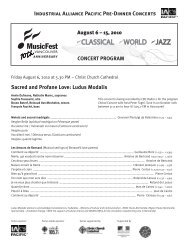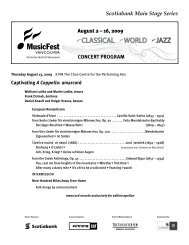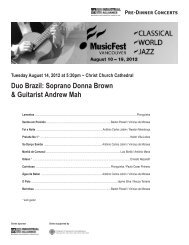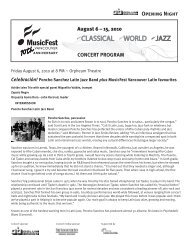Here To Stay: The Gershwin Experience - MusicFest Vancouver
Here To Stay: The Gershwin Experience - MusicFest Vancouver
Here To Stay: The Gershwin Experience - MusicFest Vancouver
You also want an ePaper? Increase the reach of your titles
YUMPU automatically turns print PDFs into web optimized ePapers that Google loves.
George <strong>Gershwin</strong> (September 26,1898 – July 11, 1937)<br />
Ira <strong>Gershwin</strong> (December 6,1896 – August 17, 1983)<br />
Strike Up <strong>The</strong> Band ........................................................................................................................................... (arr. David Snyder)<br />
Rialto Ripples / Fascinating Rhythm ................................................................................................................... (arr. Kevin Cole)<br />
<strong>The</strong> Half Of It, Dearie, Blues ..................................................................................................................... (arr. <strong>Gershwin</strong> / Snyder)<br />
<strong>The</strong> Man I Love ............................................................................................................................................................. (arr. Snyder)<br />
‘S Wonderful ................................................................................................................................................................ (arr. Snyder)<br />
But Not For Me ............................................................................................................................................................. (arr. Snyder)<br />
Rhapsody In Blue ................................................................................................................................................ (arr. Ferde Grofé)<br />
Intermission<br />
Of <strong>The</strong>e I Sing Overture ......................................................................................................................................... (arr. Don Rose)<br />
Slap That Bass ....................................................................................................................................... (arr. Johnny Green / Cole)<br />
Let’s Call <strong>The</strong> Whole Thing Off / <strong>The</strong>y All Laughed ...................................................................................................... (arr. Cole)<br />
Love Is <strong>Here</strong> <strong>To</strong> <strong>Stay</strong> ................................................................................................................................................... (arr. Snyder)<br />
Summertime ................................................................................................................................................................. (arr. Snyder)<br />
(Lyrics by Ira <strong>Gershwin</strong>, Dubose Heyward and Dorothy Heyward)<br />
I Got Rhythm ................................................................................................................................................................ (arr. Snyder)<br />
Allegro Agitato, from Concerto in F ......................................................................................................................... (arr. <strong>Gershwin</strong>)<br />
George <strong>Gershwin</strong>, born in Brooklyn, New York on September 26, 1898, began his musical<br />
training at thirteen. At fifteen he left high school to work as a Tin Pan Alley “song plugger” and within<br />
three years he had seen his first song published. Although “When You Want ‘Em You Can’t Get ‘Em,<br />
When You’ve Got ‘Em You Don’t Want ‘Em” created little interest, George’s “Swanee,” popularized<br />
by Al Jolson in 1919, brought <strong>Gershwin</strong> his first real fame. In 1924, when George teamed up with his<br />
older brother Ira, “the <strong>Gershwin</strong>s” became the dominant Broadway songwriters. This extraordinary<br />
collaboration led to a succession of musical comedies, among them Lady, Be Good! (1924), Oh, Kay!<br />
(1926), Funny Face (1927), Strike Up the Band (1927 & 1930), Girl Crazy (1930), and Of <strong>The</strong>e I Sing<br />
(1931), the first musical comedy to win a Pulitzer Prize. Over the years, <strong>Gershwin</strong> songs have also<br />
been used in numerous films including Shall We Dance (1937), A Damsel in Distress (1937) and An<br />
American in Paris (1951). Later years produced the award-winning stage musicals My One and Only<br />
(1983) and Crazy for You (1992) which ran four years on Broadway, and the current <strong>To</strong>ny-winning<br />
show Nice Work if You Can Get It (2012).<br />
Starting with his early days as a composer of songs, <strong>Gershwin</strong> had ambitions to compose serious<br />
music. Asked by Paul Whiteman to write an original work for a special concert of modern music to be<br />
presented at Aeolian Hall in New York on February 12, 1924, <strong>Gershwin</strong> responded with the Rhapsody in Blue, and opened a new era in American<br />
music. In 1925, the eminent conductor Walter Damrosch commissioned <strong>Gershwin</strong> to compose a piano concerto for the New York Symphony<br />
Society. Many feel that the Concerto in F is <strong>Gershwin</strong>’s finest orchestral work. Others opt for his An American in Paris (1928) or his Second<br />
Rhapsody for piano and orchestra, which he introduced with himself as pianist with the Boston Symphony under Serge Koussevitzsky in 1932.<br />
In 1926 <strong>Gershwin</strong> came across DuBose Heyward’s novel Porgy, and immediately recognized it as a perfect vehicle for a “folk opera” using blues<br />
and jazz idioms. Porgy and Bess (co-written with DuBose Heyward, Dorothy Heyward and Ira <strong>Gershwin</strong>) was the <strong>Gershwin</strong> brothers’ most ambitious<br />
undertaking, tightly integrating unforgettable songs with dramatic incident. Porgy and Bess previewed in Boston, and opened its Broadway run on<br />
October 10, 1935. <strong>The</strong> opera has had major revivals in each decade since its premiere, most recently this year on Broadway.<br />
In 1937, George <strong>Gershwin</strong> was at the height of his career. It was in Hollywood, while he was working on the score of <strong>The</strong> Goldwyn Follies, that<br />
George <strong>Gershwin</strong> collapsed and died of a brain tumor; he was not quite 39 years old. Countless people throughout the world, who knew <strong>Gershwin</strong><br />
only through his work, were stunned by the news as if they had suffered a personal loss. Some years later, John O’Hara summed up the feelings<br />
that abide: “George <strong>Gershwin</strong> died July 11, 1937, but I don’t have to believe it if I don’t want to.”






